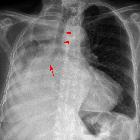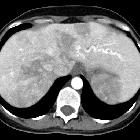Bronchial arterial aneurysms
Bronchial arterial aneurysm refers to any form of aneurysmal dilatation involving any segment of the bronchial artery. The term is sometimes used synonymously with a bronchial arterial pseudoaneurysm .
Epidemiology
They are a rare entity and are reported in <1% of those who undergo selective bronchial arterial angiograms .
Clinical presentation
Most patients are asymptomatic until they rupture. A large mediastinal aneurysm may present as a mediastinal mass, acute superior vena cava obstruction or dysphagia .
Pathology
Their exact pathogenesis is not well known. Most cases have been reported in patients with the following background conditions:
- silicosis
- bronchiectasis
- lung cancer
- recurrent infection
- thoracic trauma
- Rendu-Osler-Weber syndrome
Bronchial artery aneurysms have also been found in individuals with predisposing congenital conditions and systemic vascular diseases such as cystic fibrosis and atherosclerosis. In patients without predisposing pulmonary or systemic disease, bronchial artery aneurysms are extremely rare.
Location
They can be mediastinal (juxta-aortic) or intrapulmonary.
Treatment and prognosis
The treatment options for bronchial artery aneurysm include transcatheter embolization, placement of a covered stent, and surgery.
Complications
Catastrophic hemorrhage is is one of the most feared complications.
See also
- bronchial artery pseudoaneurysm
- pulmonary arterial aneurysm
- Rasmussen aneurysm
- bronchial arterial enlargement
Siehe auch:

 Assoziationen und Differentialdiagnosen zu bronchial arterial aneurysm:
Assoziationen und Differentialdiagnosen zu bronchial arterial aneurysm:





